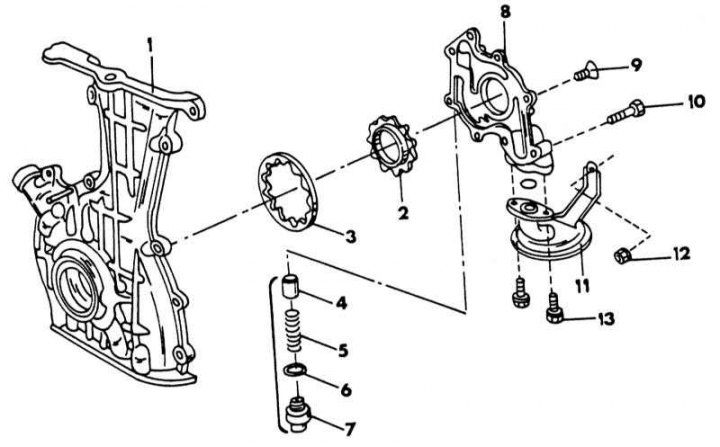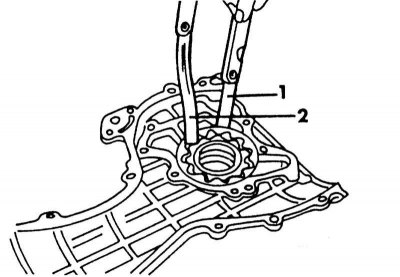Removal and installation of the pump
1. Removal and installation of the oil pump on the injection and carburetor engines is carried out in the same way.
2. Remove all drive belts on the front side of the engine.
3. Remove the cylinder head (Chapter Cylinder head and timing gear).
4. Remove the oil pan (Chapter Cooling and heating systems).
5. Remove the oil suction screen and oil guide plate.
6. Remove the camshaft drive cover (Chapter Cylinder head and timing gear).
7. Disassemble the pump as described in the next chapter.
8. Before installing the camshaft drive cover, remove any remaining sealant with a scraper. Also clean the surface of the cylinder head. Cover the surface of the cover with sealant and install all parts in reverse order.
Oil pump overhaul

Engine Oil Pump Parts
1 - cover of the timing mechanism drive; 2 - internal gear of the pump; 3 - external gear of the pump; 4 - piston of the pressure reducing valve; 5 - pressure spring; 6 - sealing washer; 7 - cork; 8 - oil pump cover; 9 - bolt, 4-5 Nm; 10 - bolt, 6.5-8.5 N·m; 11 - oil suction grid; 12 - nut, 6.5-7.5 Nm; 13 - bolts, 13-16 Nm
The illustration above shows an injection engine oil pump. The carburetor engine uses the same parts, only the gears have a different design.
1. Unscrew the cover from the inside of the camshaft drive cover, wipe both gears, and use a small screwdriver to make a mark on the outside of both gears. In a carburetor engine, the inner gear has a groove along the outer circumference, which, after assembling the pump, must face towards the pump cover.
2. Remove both gears from the pump bore.
3. Remove the pressure reducing valve after removing the plug with the spring.
4. Insert both gears back into the housing and measure the clearance between the top side of the pump housing and the top side of the gears by placing a steel straightedge and measuring with a flat feeler gauge as shown in the illustration. The maximum allowable clearance is 0.10 mm between the ruler and the inner gear and 0.11 mm between the ruler and the outer gear. If required, the clearance can be slightly reduced by slightly removing the surface of the pump housing with sandpaper.

Measuring the axial clearance of the pump gears using a steel ruler (1) and probe (2).
5. Insert a narrow feeler gauge between the outside of the outer gear and the housing bore. The gap should not exceed 0.20 mm. The illustration below shows the measurement. Also, as shown in the illustration, measure the gap between the teeth lying together. The gap must be less than 0.18 mm.

Measuring clearances between pump outer gear and bore (1), as well as between the teeth of the pump gear (2).
6. At the carburetor engine pump, a sickle-shaped insert is inserted into the housing. For such a pump, measure the gaps between the bushing and the teeth of the corresponding gear and compare with the data given in Specifications.
7. If the measured values exceed the wear limit, either the pump gears or the camshaft drive cover should be replaced. The oil pump is assembled in the reverse order. Insert gears as indicated. On an internal pump gear on a carbureted engine, the side of the gear with the outer groove must be visible before installing the pump cover. Lubricate the pump gears well before installation so that the pump does not seize when the engine is first started. If pressure reducing valve parts have been replaced, the condition of the valve piston bore should be checked. Screw in the plug with a new gasket and tighten to 50 - 70 Nm (for injection engine) or 40 - 60 Nm (for carbureted engine).